Doberman Pinscher: characteristics of the breed and the subtleties of the content
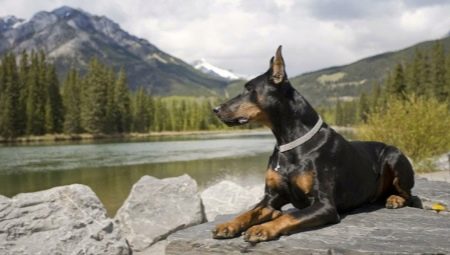
Doberman is an animal with high intelligence and noble appearance. In many films, the Doberman is presented as a fierce defender with an aggressive personality. But this dog is not only a vigilant guardian and guard, but an amazing companion dog, a loyal member of the family.
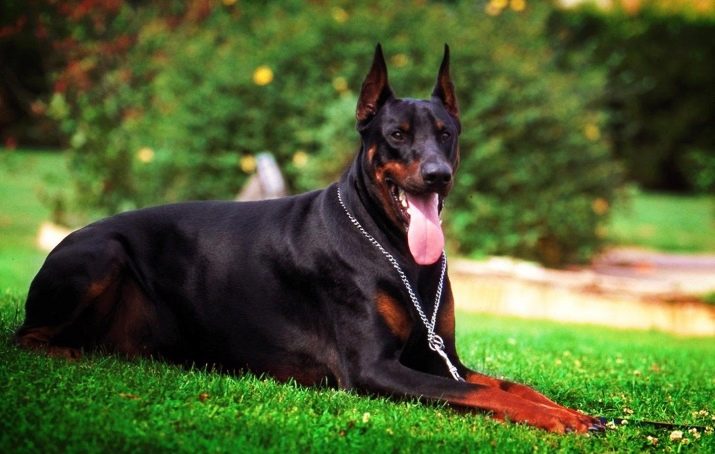
History of origin
The creator of the breed is Frederic Louis Dobermann, who lived in the German city of Apollo in 1834-1894. Various sources mention that he changed a variety of professions: tanner, mortgage worker, night watchman, tax collector. His work was not safe - walking around the city with the collected money was associated with the risk of being attacked by bandits, so Frederick thought that he needed a guard dog.
According to the creator of the breed, a dog should harmoniously combine such qualities as high intelligence, endurance, strength, courage, and devotion. And also ideal for defense, that is, to have certain fighting qualities. Unfortunately, the initiator of the creation of the breed did not leave any records, so a lot of information about the Doberman will remain a mystery. This creates certain difficulties for modern dog handlers, because the concept of dog breeding cannot be unambiguously traced.
At the origins of the breeding of this breed, in addition to hybrid dogs, were the short-haired pinscher, the German shepherd, the German pointer, the Rottweiler, the Manchester terrier, the greyhound. According to Dog Magazine from 1910, the Doberman also has an admixture of the blood of the French Beauséron with which it bears a resemblance.
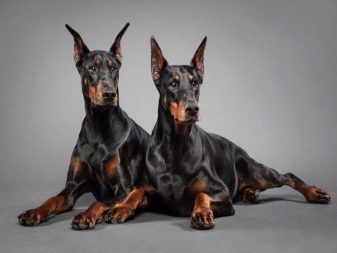
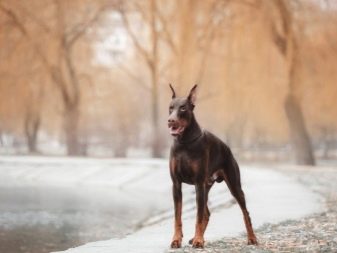
The modern Doberman's pedigree begins with a dog named Count Belling von Grunland. (1899). She was only slightly different from the Rottweiler. From the very beginning of the creation of the breed, the main idea was the ease of use of the dog. German breeders continued to work on the development of the Dobermann breed. Their main goal was to form the character and functions of the dog, which he was supposed to perform. Appearance was secondary. The choice of dogs for breeding fell on only the most daring, fast and intelligent individuals.
In 1899, the German Dobermann Pinscher Society was founded. Initially, the breed was called that way, but in the middle of the twentieth century, the use of the second word was discontinued.

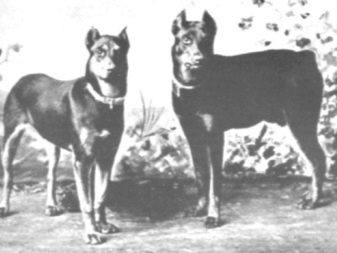
Due to its extraordinary courage, endurance and calm reaction to shots, the Doberman was rated as a police and military dog. He proved himself during both world wars.
During the First World War, he was included in European military units as a service and sanitary dog. This fearless and trustworthy dog also caught the attention of the US military.
During World War II, he served in the military on both continents. During this time, he also acquired a notorious reputation as a service dog in the concentration camps. During the war, 45 thousand dogs served in the German army. They were used as couriers for the transmission of military reports, and they often had to be under enemy fire. Also, dogs of this breed proved to be excellent bloodhounds: they could follow the trail for 4-5 days and even longer.
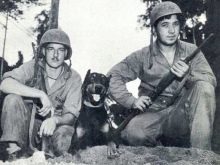
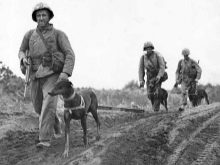

Description of the breed
According to the description of the breed standard, Dobermans are medium-sized dogs, muscular, athletic, but not overweight. The upper line is slightly inclined, the lower one is tucked up. The silhouette of the dog looks more square than elongated. The height at the withers is approximately equal to the length of the body.
Characteristics of the breed:
- Height at withers - males - 70 cm (± 2 cm), females - 66 cm (± 2 cm).
- Weight - males - 43 kg (± 2kg), females - 33 kg (± 2kg).
- The head is proportional to the body, wedge-shaped. The edge of the forehead is small, but clearly marked.
- The ears are of medium size and set high. Can be docked. But not in all countries dogs with cropped ears are allowed to show.
- The bite is scissor bite.
- The eyes are oval, dark in color.
- The skin is intensely pigmented.
- Coat - short, hard, smooth, tight-fitting, without undercoat.
- The color is black, dark brown or gray.
- High tail. Very short cut, leaving only 2 vertebrae visible. It is allowed to leave it in its natural form.
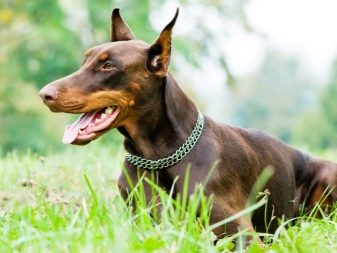
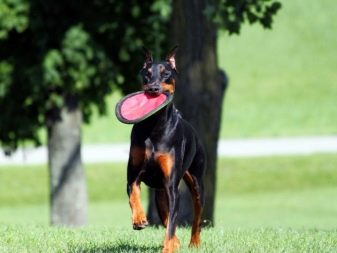
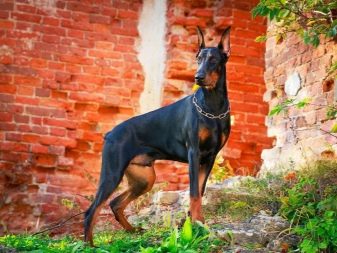
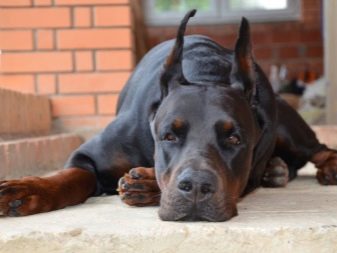
Disqualifying disadvantages:
- shyness, shyness, nervousness and excessive aggression;
- eyes yellow, blue, or different colors;
- no teeth, no scissor bite;
- the coat is not short or with white spots.
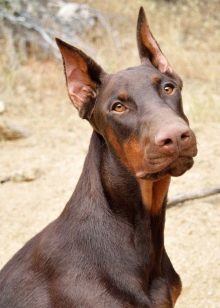
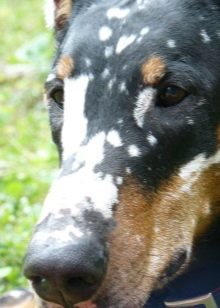
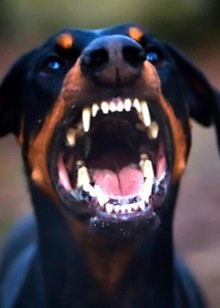
The average lifespan of these dogs is 10-11 years. The Doberman is considered a healthy dog. However, it is worth knowing what diseases he may still be susceptible to.
- Dysplasia of the hip joint. Before buying a puppy, you should ask the breeder to check his parents for dysplasia.
- Progressive retinal atrophy is a gradual deterioration in vision. The disease is hereditary.In many countries, breeders are required to conduct an examination of puppies - electroretinography.
- Von Willebrand disease is a hereditary pathology that interferes with the ability of the blood to clot.
- Hypothyroidism is a dysfunction of the thyroid gland, as a result of which the dog can suffer from epilepsy, alopecia, obesity, drowsiness and skin diseases.
- Wobbler's syndrome is a malaise that occurs in puppies. Due to its rapid growth, the spinal cord can be compressed in the cervical spine. As a result, the dog loses control of the hind limbs. The animal begins to limp.
- Cardiomyopathy is a myocardial disease in which irreversible changes in muscle fibers occur. Their shape, elasticity and contractile ability change so that the heart muscle loses its efficiency.
- Albinism is a genetic mutation. Albino Dobermans have many different diseases, including photophobia.
- Narcolepsy is bouts of drowsiness.
- Disorders of the stomach.
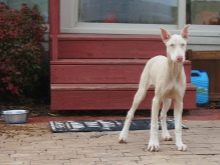
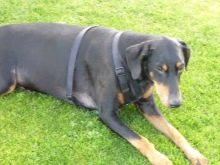
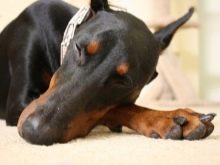
The correct diet, care and periodic consultation with the veterinarian will help to keep your pet's health and life.
How is it different from a pygmy Doberman?
The German pinscher (smooth-haired pinscher) originated in the 1800s when it was closely related to the standard schnauzer (rough-haired pinscher).
Crossing between the German Pinscher and the Standard Schnauzer was approved. The aim of this was to renew the gene pool of the breeds and reduce the health problems associated with the dogs.
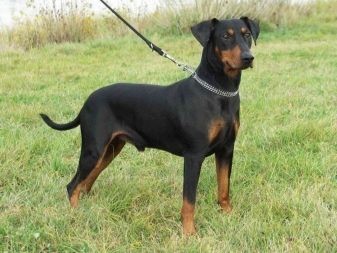
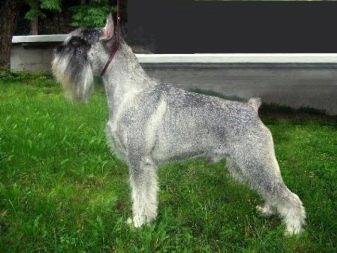
In the Doberman standard, males range in height from 66 cm to 71 cm, and females from 61 cm to 66 cm. Adult bitches can be the same size as males, but should not be taller than males. Their body weight is 30-40 kg.
Dobermans have short and sleek fur of black, dark brown, gray or fawn color. It is a strong muscular animal.
The Doberman has an almond-shaped eye shape. The nose is black in black dogs, brown in red dogs, dark gray in grays and dark in fawn.
Dogs live an average of 10-11 years. 3-8 puppies are born in the litter. Dobermans are smart, learn fast. They are more patient (than their mini brothers) and willing to do whatever is required of them.
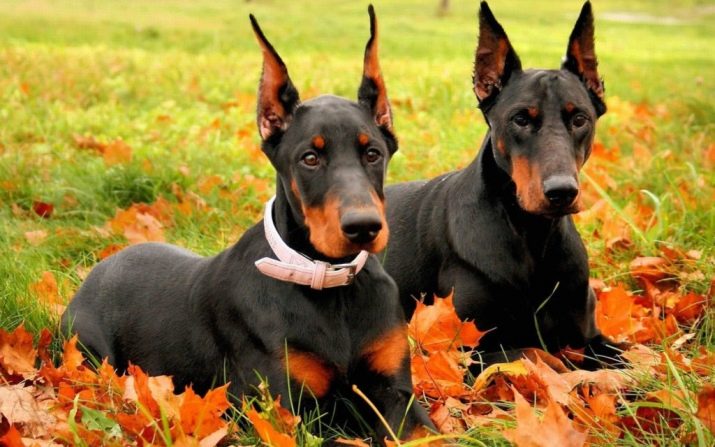
German Pinscher with a height of 43 to 51 cm and weighing about 5 kg. This is a dog of medium build, has well-developed muscles. The hind legs are shorter than the front ones. The coat is smooth, color - black, brown. Can be of two colors. The eyes have an oval cut. All German Pinschers have black eyes, black lips, black noses, and black claws regardless of the color of their fur. Their life expectancy is up to 15 years.
German Pinschers are terriers at heart. They like to be fun, smart and quick to learn. But they are also stubborn.
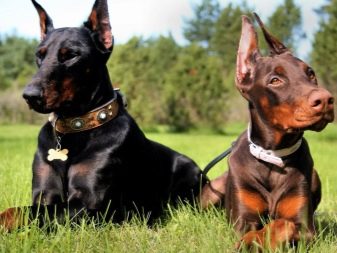
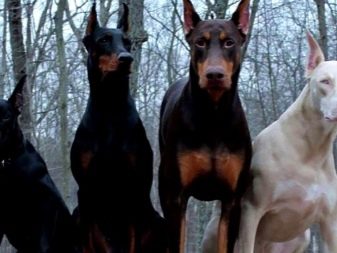
Miniature Pinschers are miniature copies of the famous Dobermans, but despite the obvious similarity, they are not related. These dogs are very cheerful and energetic. Like Dobermans, they are ideal companions for various games, long walks and travels.
The Mini Doberman is a friendly and fearless dog. She has an innate intelligence, so she is very trainable and quickly learns new skills. Miniature size does not prevent her from being an excellent guard and guard dog.
Karl Friedrich Louis Dobermann was able to breed a dog similar to a miniature pinscher, but more impressive in size.
The Doberman is a very popular breed, but the Miniature Pinscher wins over it because it can live in even the smallest city apartments. Interest in miniature dog species is growing every year, as is the number of nurseries raising them.
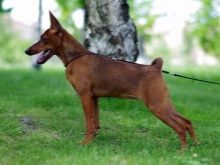
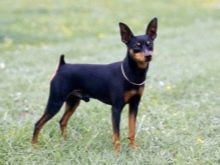
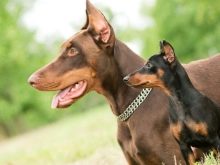
Character and behavior
The Doberman is a very intelligent and active dog, loyal and trustworthy. He will act without hesitation when he finds his family in danger. Despite being a great defender, he generally doesn't show his aggression for no reason.
Doberman Pinscher loves all types of physical activity. He learns commands very quickly, but learning should start relatively early. During training, high responsibility and firmness of the trainer is required.
An important feature of this breed is a high degree of sensitivity, constant vigilance and careful registration of everything that happens around. For dogs of this breed, a strong bond with the owner and his family is very important. And this question, and the whole process of socialization, education, training of Dobermans require more diligence, time and attention than when training other dogs.

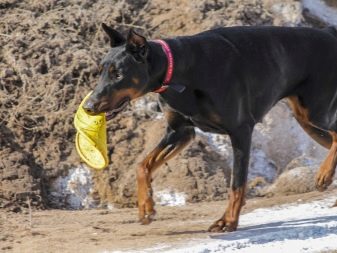

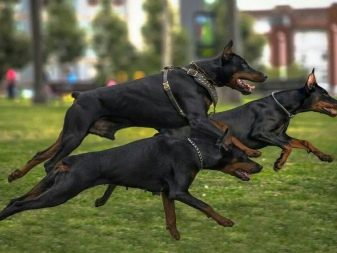
Unlimited affection for the owner, incorruptible nature of this dog exclude the possibility of transferring it to other hands. A devoted dog feels disappointed and deceived. This can lead to abnormal behavior, mistrust and aggression.
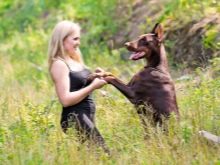
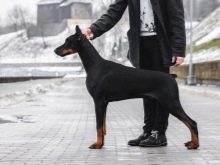
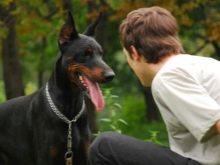
A psychologically healthy Doberman does not show a tendency to intentional aggression towards people and animals. Various sources describe the case when a Doberman brought a herd of young striped boars to the village. Their mother had been shot and killed the day before while hunting. On another occasion, the same dog was seen at the edge of the forest playing with two young deer.
Conscientious breeders select calm and balanced dogs for breeding. But due to the popularity and massiveness of this breed, there are cases of an unprofessional approach to breeding, therefore, in some individuals, excessive aggression or cowardice is observed - signs that are denied by the breed standard.
One of the main advantages of the breed is that Dobermans are highly intelligent... This means that the dog is very receptive to training, training and socialization.
The disadvantages of the breed include the fact that they can be potentially dangerous to people and animals around them due to their impressive size, strength and aggression against strangers.
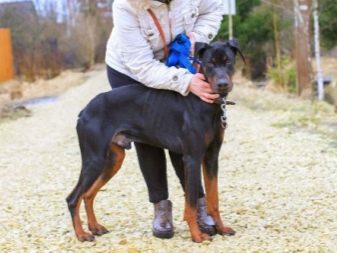
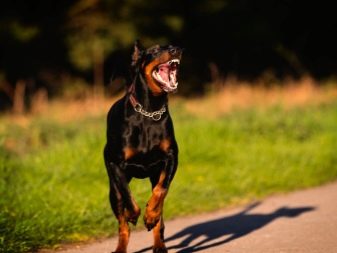
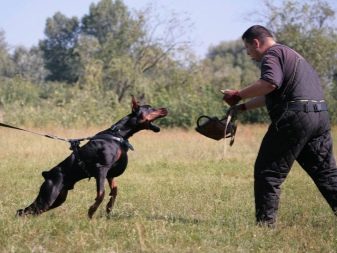
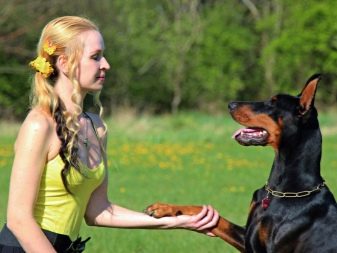
A well-bred Doberman is an excellent family dog. Provided that the training and socialization of the puppy is carried out properly, the Doberman will be a reliable dog that will protect you from danger if necessary. It is also important to teach children how to handle this breed correctly.
Doberman Pinscher gets along well with other animals that are in the family. It is good if they were taken to the house at the same time. They can be aggressive towards unfamiliar dogs if they think they pose a risk to their owner or family members.
The Doberman is a protective and guard dog. He is confident and fearless, ideal for police or military service. Nevertheless, their character is quite peaceful. With a person whom the dog trusts, he will behave very friendly.
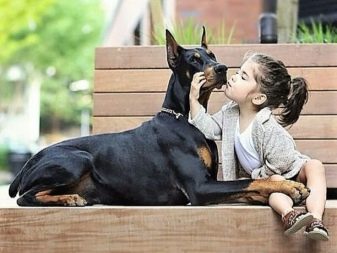
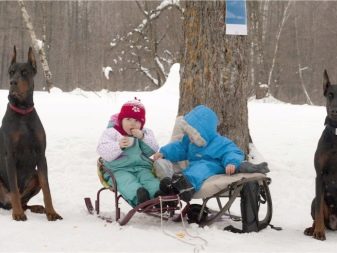

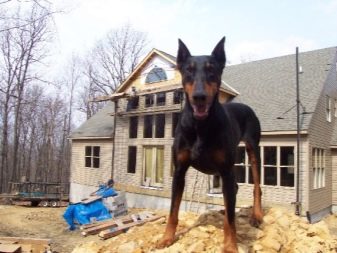
How to choose a puppy?
Representatives of the Doberman breed are strong, agile, resilient, graceful and loyal dogs of their owners. The Doberman is a great small animal hunter, guard and warrior. But for many, he is primarily a loyal friend. Choosing a puppy requires a responsible approach.
- To begin with, you need to decide for what purpose the puppy is being purchased - participation in large exhibitions, for reliable protection, or simply as a faithful friend.
- The gender of the puppy is chosen at your discretion. If the future owner wants to see a gentle and attentive dog in his house, it is worth choosing a female. If you dream of a tall, noble, amazing companion, you should choose a dog.
- Ask the breeder about the habits and characteristics of the puppy. With this information, you can tell how the future pet will grow.
- It is important to carefully consider the appearance of all Doberman puppies provided by the breeder. Dogs should have clean, well-groomed fur.
- There should be no light spots on the skin, light eyes, twisted limbs. Examine your puppy for an umbilical hernia.
- A healthy puppy has clean eyes, shiny coat. He should have a good appetite, be agile and joyful.
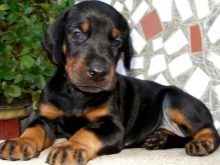
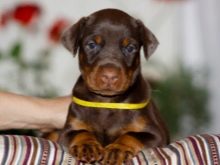

Experienced breeders unite in associations, so it is better to contact well-known catteries that have proven themselves well. The breeder must provide all information about the puppy, certificate of vaccinations and examinations passed.
At the request of the buyer, the breeder must also provide medical documentation of the parents of the future pet. A good breeder places great emphasis on the health and socialization of animals before they are transferred to new homes.

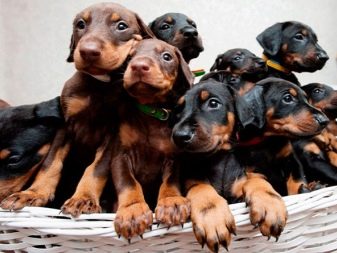
How to care?
Doberman pinscher daily care is not difficult and does not take much time. This is a rather large dog, however it is often kept in apartments.
It is widely believed that smooth-haired dogs, especially those with no undercoat, do not need much grooming. Indeed, Doberman owners do not know the problems of tangling and felting fur. But there is another nuisance here - short hair loss almost all year round. The stiff bristles stick to carpets and upholstery and are very difficult to remove.
Regular grooming of the coat can significantly reduce the problem of shedding. Wool falls out when it is damaged or dry. It must be nourished regularly - spray it with conditioner containing high-quality oils 2-3 times a week, and always apply a regenerating balm after the bath. With this care, the coat will become healthier, silky, stronger and less shedding.
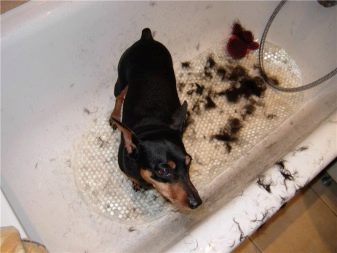
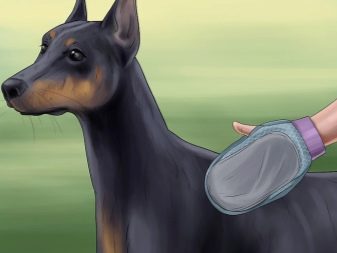
Due to shedding, the dog needs to be brushed regularly with a thick-bristled brush. The rubber brush is also very good, but only with soft tips adapted to the size of the dog. A hard brush can damage the coat. Wire and metal brushes are not suitable for Doberman wool.
Bathing frequency is arbitrary. Usually a Doberman is bathed when it gets dirty, but at least 4-5 times a year. It is believed that bathing smooth-haired dogs is not necessary, but it should be remembered that not only ordinary dust settles on the coat, but many different chemicals that dry it out. Therefore, the dog must be washed, and the balm applied after rinsing creates a protective film against the aggressive effects of reagents.
For bathing, use shampoos or care products adapted to the current needs of the coat. In case of dryness or problems with the skin, it will be a regenerating shampoo, in case of problems with color, it will be a color enhancing agent.
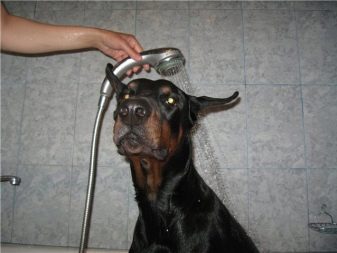

If for some reason it is not possible to bathe the dog, but it gets dirty, you can wipe the coat with a damp cloth soaked in water or a special lotion.
Your pet's eyes and ears also require regular grooming and cleaning. Due to the tendency to tartar formation, you need to brush your dog's teeth 2-3 times a week. It is recommended to cut the nails 2-3 times a month.
To prepare for the show, the dog needs to be very thoroughly cleaned, combed and rubbed with a special conditioner to make it soft and shiny. The nails should be trimmed so that they do not touch the floor. It is best to do this a week before the show.
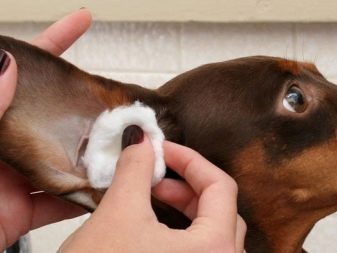
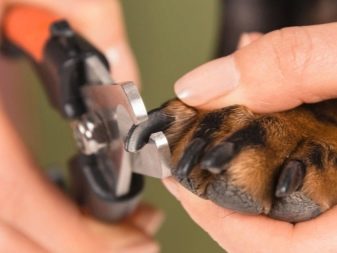
The dog on the show must have an impeccable figure, run elegantly and effortlessly, with his head held high. Therefore, it is worth paying attention to the correct maintenance and nutrition of the dog.
Dobermans are more suitable for keeping outside the city than in city apartments. They need to move a lot, which can be very tiring for some owners (especially after a hard day at work). The fenced yard of a private house will give the Doberman ample space to run when there is no way to walk the pet.
Since the Doberman is a dog who is very loyal to his master and loves his family, he should not be left alone for a long time. The pet must be part of the family and participate in all family activities.
Mismanaged or neglected dogs often have bad habits that are difficult to eradicate.From boredom and unfulfilled ambitions, they become nervous, restlessly run around the house or bark in response to every sound. Well-bred dogs are calm and balanced.
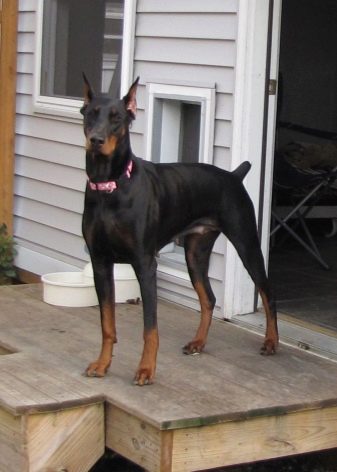
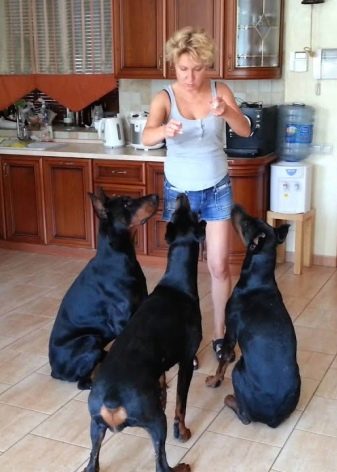
To prevent the onset of illness, the dog should be cared for and monitored for the condition of its ears. However, cleaning procedures should not be performed too often. Veterinarians advise examining the ears once every two weeks to prevent possible inflammation.
The most suitable accessory for cleaning your ears is a piece of cotton wool wrapped around your finger. To remove dirt, you can use a special preparation for cleaning the ears of dogs (preparations are made on the basis of oil so that they do not harm the animal). It should be remembered that the inside of an animal's ear is extremely delicate and easily damaged. Therefore, cleaning must be done carefully.
Dogs with drooping ears require much more frequent monitoring. This does not mean that animals with erect ears do not suffer from diseases and inflammations of the hearing organs. Dogs with open ears are prone to scratching, irritation, and damage to the outer part of the ear. They are also very vulnerable to parasite attacks.
A very serious threat to an animal is water entering the auricle. This can happen both while swimming and while playing. Every time you bathe the Doberman, you need to protect its ears, and in case of water ingress, dry it correctly. When the dog dries up, it usually shakes its head, which leads to a partial drainage of water into the ear canal. Water in a dog's ears can cause infections and inflammation.


Parasites pose a great danger to the dog. When walking in the woods or when keeping in a yard with tall grass, you should be extra vigilant. There is a great risk that parasites can enter your pet's ears, which can damage the internal organs of hearing.
Power features
The quality of nutrition directly depends on whether the dog will be healthy and full of strength and energy, or whether its existence will be overshadowed by constant diseases.
Doberman pinscher can be fed both dry food and natural products. But it's worth remembering that he has a huge appetite. An adult dog needs fresh meat, vegetables and cereals every day, and in strict proportions according to the age of the animal. This is a more expensive option than dry dog food available at the pet store.
For economic reasons, you might consider feeding your pet prepared dry food. It is also very convenient, since this type of food is well balanced and adapted to the various needs of the animal. The manufacturers indicate the rules of feeding and dosage of portions in accordance with the age of the animal on the labels, this helps the owners to organize the feeding of the pet competently and effectively.

It is important to choose only high quality premium feed. By purchasing such a diet for feeding a Doberman, you can be sure that it will ensure the health and proper development of the dog.
Because of the risk of stomach problems, it is worth dividing your daily meal into two meals. After eating, the dog should rest for at least two hours.
Dogs should have unlimited access to clean, fresh water.
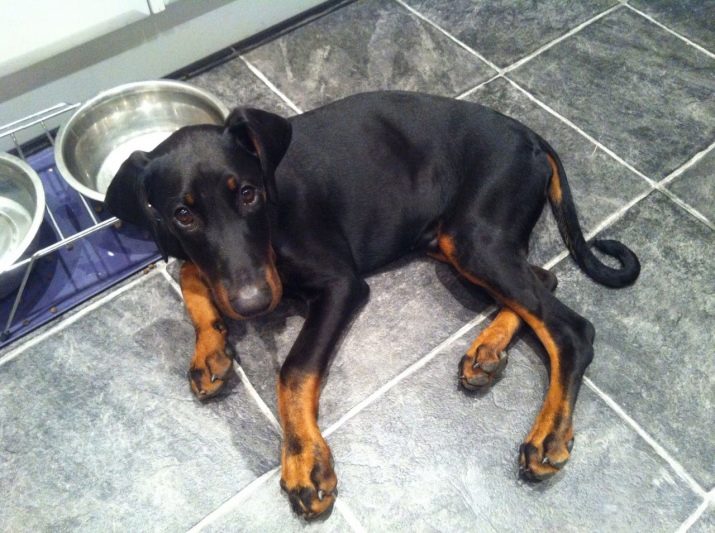
Docking ears and tail
Copying the ears and tails of the Doberman has both supporters and opponents. The following are the most commonly used arguments for cupping.
- The dog looks better and more recognizable if his tail is docked and his ears are nicely set.
- It is difficult for hobbyists and breeders to get used to the natural look of tetrapods. It is believed that a pet should have its tail cut off in order to increase the chances of winning in shows.
- With long tails, hunting injuries are possible.
- A dog with docked ears and tail looks more menacing.
- Some breeders claim that when the ears are cropped, dogs are less likely to get an infection.
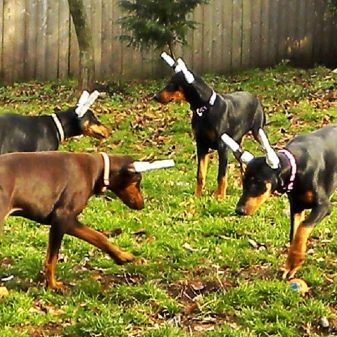
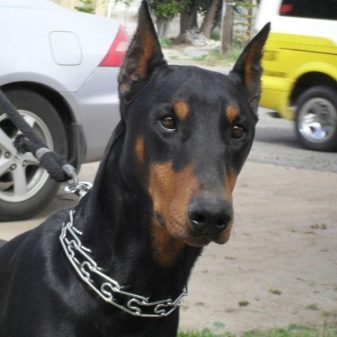
Below are some of the most recurring arguments of opponents of cropping.
- The pain accompanying stopping is strong and sudden, but it disappears over time. However, there is chronic pain that the animal feels long after the wound has healed. Studies in lambs who also have their tails docked have shown that they feel pain for 3-4 hours after surgery.
- Scientists suspect that ear cropping makes dogs suffer long after amputation. Research has shown that dogs docked several years ago suffered from the pain of their docked tails. This can cause the pet to become nervous or unpredictable.
- Docking the ears and tails makes it difficult for the dog to properly transmit body signals. When a dog is calm, its tail is lowered and its ears are flattened, and vice versa: an excited dog has its tail and ears raised, but in docked animals it is difficult to determine the mood. Perhaps that is why there are frequent cases of attacks on them by other dogs. This can also provoke retaliatory aggression.
- Some cropped Doberman owners admit that their dogs are aggressive towards their owners and family members.
- The muscles of the tail, croup and pelvic region are connected to each other. Tail docking is therefore associated with muscle dysfunction. This can cause unwanted problems in the dog such as fecal and urinary incontinence, perineal hernia.
- It is assumed that the muscles of the hind limbs may not develop correctly in animals that have had their tail removed in the first days of life.
- Sometimes the tail and ears are docked by amateurs, and the wrong setting of the ears can ruin the dog's appearance for life.
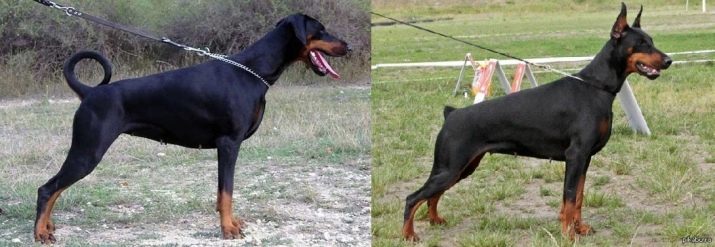
Fortunately, for animal welfare reasons, ear and tail trimming was banned in the 1990s. The natural ears and long tail gave the dangerous Dobermans a softer and more friendly look.
After that, many dog breeders ceased to be interested in the Doberman and the breeders refused to breed the breed. Despite this, the adorable, hanging-eared Dobermans gained many new fans and remained a very popular breed. A strong guard dog has become a very desirable family dog.
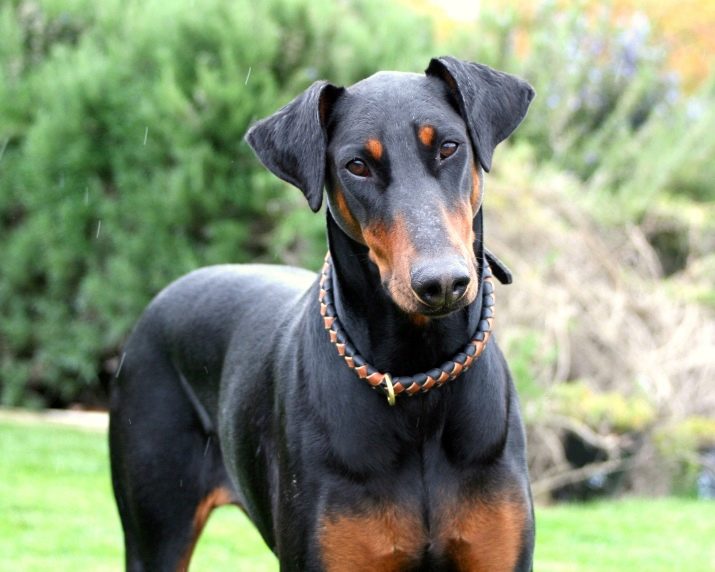
Education and training
Dogs of this breed are usually obedient and love to work. They easily adapt to new situations and environments, but at the same time they are ambitious and goal-oriented. Dobermans are also considered to be very intelligent dogs with a high level of intelligence. Those who value these qualities and try to maintain them will get an excellent family dog.
Doberman Pinscher requires a solid upbringing and socialization from an early age. As with humans, the first months of life are crucial for Dobermans. Dogs of this breed should come into contact with people and other animals as soon as possible, especially if they are later sent to families with children.
Positive experiences during the puppy's growth will shape the dog's character for life. Through their quick wits and adaptability, the Doberman quickly learns to recognize certain situations as normal and safe for their human family.



A well-mannered and socialized dog will not attack or bite anyone for no reason. Doberman Pinscher can perfectly control his attention and aggression when he hears the command. The pet needs an experienced and reliable owner who will clearly and consistently educate and train him. When such a person once gains the trust of a Doberman, the dog will become his loyal and devoted pet for life. The Doberman is a mirror image of its owner, which is much more noticeable in this breed than in other dogs. Thus, the owner can be assured of a controlled and obedient companion at the same time.
Training and education of dogs of this breed requires a lot of patience from the owner, as well as investment of time and money.But all this is worth it, since professional education, sufficient movement, creative games and exciting tasks are the basis of a harmonious life for a dog and a person.

Suitable nicknames
When choosing a name for a dog, it is worth considering the individual characteristics of the pet: breed, size, character and temperament. You can give the dog a simple nickname, which is more popular, or you can reward your pet with an exotic name.
Here are some examples of nicknames for boys:
- Sparky;
- Sheldon;
- Brutus;
- Teddy;
- Mike;
- Grow;
- Jake;
- Jazz;
- Archie;
- Rex;
- Rhine;
- Balto;
- Rocky;
- Hermann;
- Scooby;
- Leader;
- Onyx.
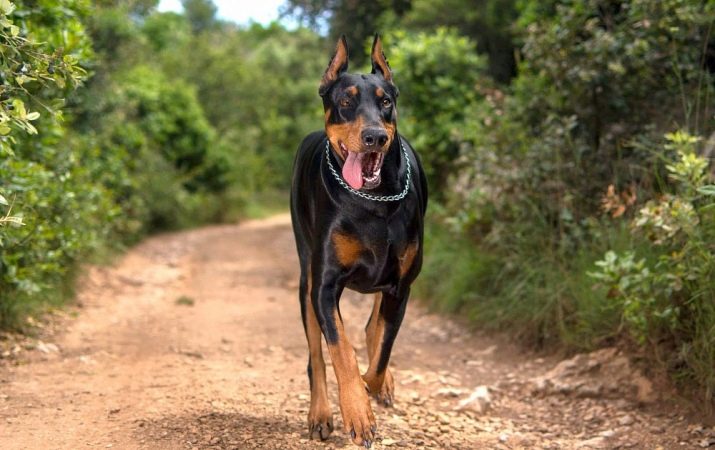
You can choose a nickname for girls from this list:
- Belle;
- Tiana;
- Rihanna;
- Selena;
- Amy;
- Ashley;
- Jessica;
- Adele;
- Buffy;
- Gerda;
- Xena;
- Moon;
- Lady;
- Roxy;
- Skoda.

Owner reviews
According to most owners, Dobermans are the most beautiful and wise pets. Someone thinks that these dogs can be safely left at home with children. But most owners are inclined to believe that this is still not worth doing. It is difficult to predict the behavior of a dog without the presence of the owner nearby. In addition, children may not know how to behave properly with a Doberman and may provoke the dog to aggressive behavior.
Dogs are very attached to their master and remain faithful to him for life. These dogs have a hard time parting with their owner. This can cause an adult dog to become angry, uncontrollable and aggressive behavior.
Doberman Pinscher is one of the most elegant breeds in the world: an athletic, muscular body harmoniously combines with a high intelligence of the dog.
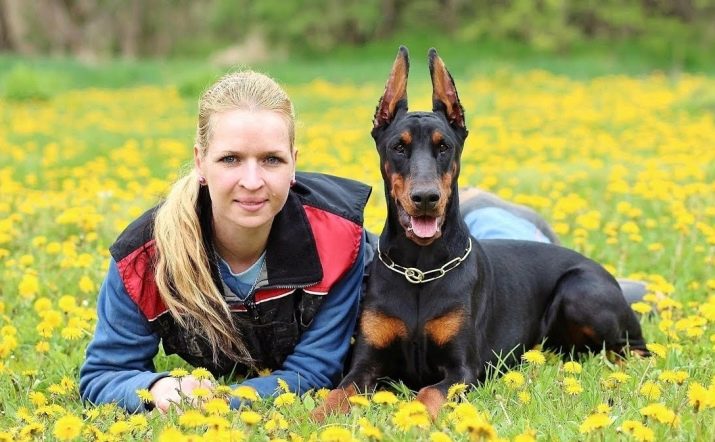
This dog is a real pride for its owner. But it requires considerable effort in training and education. She needs a lot of training, movement in the fresh air. It is the perfect companion for athletic people.
Dobermans love fun and active games with their families. Sometimes this can be inconvenient, especially when keeping a pet in an apartment. Therefore, dogs need to pay a lot of attention, affection and love.
Dobermans are very sensitive to the mood of the owner and try to cheer him up as soon as possible if they see that the owner is sad. They are loyal and loving pets. They are infinitely loyal to their family and are ready to protect it from any threats. At the same time, they do not trust strangers and can show aggression towards them.
Apart from intense training and the difficulties of upbringing, Dobermans are not whimsical in care and maintenance. But they have a tendency to damage property, eat things in the house and be restless, so the dog needs proper and timely education.
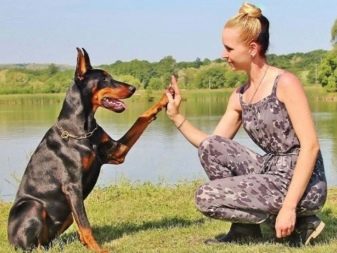
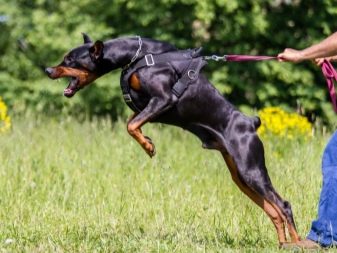
A Doberman is more suited to being kept in a private house with a fenced-in area than in an apartment. But in city apartments they are willingly turned on. In this case, you need to provide the pet with a sufficient level of mobility and often walk with him in the fresh air.
Although Dobermans have a reputation for being fierce protectors and fierce guards, with proper upbringing, they can be very gentle and affectionate. But only with your family members. Through guardian qualities, courage and strength dogs of this breed are ideal for police and security service, but on condition that one person will work with them, since the Doberman does not recognize several owners.
A full description of the Doberman breed is in the next video.


































